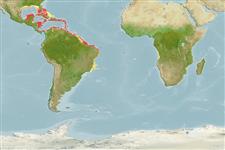Issue
Matsuura (2003: Ref. 53032) places this species in the genus Rhinesomus.
Environment: milieu / climate zone / depth range / distribution range
Ecologia
marinhas associadas(os) a recifes; intervalo de profundidade 3 - 50 m (Ref. 11227). Subtropical; 32°N - 35°S, 99°W - 14°W
Western Atlantic: Florida (USA), Bahamas, and southern Gulf of Mexico to Brazil. Eastern Atlantic: Ascension Island (Ref. 3696).
Tamanho / Peso / Idade
Maturity: Lm ? range ? - ? cm
Max length : 48.0 cm TL macho/indeterminado; (Ref. 7251); common length : 20.0 cm TL macho/indeterminado; (Ref. 5217)
Whitish with numerous small black spots on carapace, caudal peduncle and caudal fin; lips whitish; bases of dorsal, anal and pectoral fins blackish; large adults with black spots missing from three small areas in a diagonal row anteriorly on body at level of eye, appearing as three white spots (Ref. 13442).
Found in clear water around coral reefs. Sometimes under ledges and near small holes (Ref. 9710). Feeds on a variety of small bottom invertebrates such as mollusks, crustaceans, starfishes, sea urchins, sea cucumbers, sessile tunicates, sea grasses (Ref. 3696), algae, crabs and brittle stars (Ref. 13442). Toxins released when excited kills other fishes (Ref. 5521). Probably marketed fresh locally (Ref. 3696).
Life cycle and mating behavior
Maturities | Reprodução | Spawnings | Egg(s) | Fecundities | Larvas
Robins, C.R. and G.C. Ray, 1986. A field guide to Atlantic coast fishes of North America. Houghton Mifflin Company, Boston, U.S.A. 354 p. (Ref. 7251)
Categoria na Lista Vermelha da IUCN (Ref. 130435)
Ameaça para o homem
Reports of ciguatera poisoning (Ref. 30911)
Utilização humana
Pescarias: espécies comerciais; Aquário: Espécies comerciais
Ferramentas
Relatórios especiais
Descarregue XML
Fontes da internet
Estimates based on models
Preferred temperature (Ref.
123201): 25.4 - 28, mean 27.3 °C (based on 200 cells).
Phylogenetic diversity index (Ref.
82804): PD
50 = 0.6250 [Uniqueness, from 0.5 = low to 2.0 = high].
Bayesian length-weight: a=0.03548 (0.01700 - 0.07404), b=2.81 (2.62 - 3.00), in cm total length, based on LWR estimates for this (Sub)family-body shape (Ref.
93245).
Nível Trófico (Ref.
69278): 3.2 ±0.2 se; based on diet studies.
Resiliência (Ref.
120179): Elevada, tempo mínimo de duplicação da população menor que 15 meses (Fec assumed to be > 10,000).
Fishing Vulnerability (Ref.
59153): Moderate vulnerability (38 of 100).
Nutrients (Ref.
124155): Calcium = 23.4 [9.0, 73.1] mg/100g; Iron = 0.605 [0.299, 1.439] mg/100g; Protein = 19 [17, 21] %; Omega3 = 0.158 [0.081, 0.301] g/100g; Selenium = 20.2 [8.6, 44.3] μg/100g; VitaminA = 22.2 [5.5, 97.3] μg/100g; Zinc = 0.693 [0.441, 1.110] mg/100g (wet weight);
